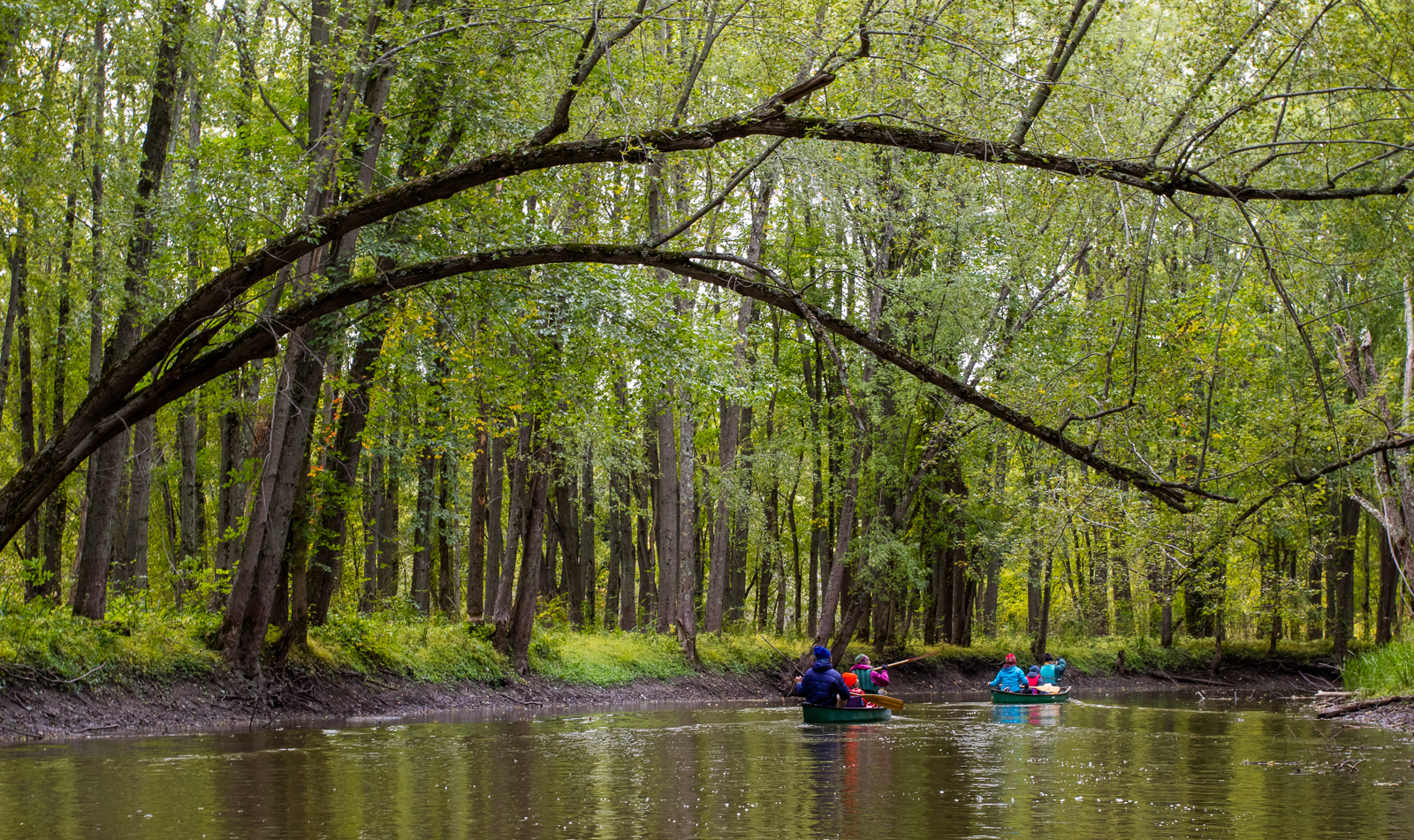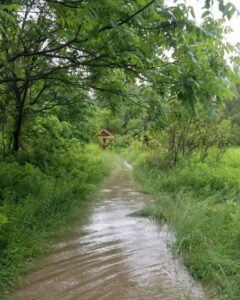Lessons from a Floodplain Forest

By Sean Beckett, Program Director
On a winter night in January, Montpelier threw a film festival about living with rivers. The evening featured kayaking documentaries, student proposals for riverside parks, and nonprofit vignettes trumpeting the now well-known lesson that rivers need “Room to Roam.”
The festival was held in a basement-level auditorium adjacent to the Winooski. So in July, the river roamed right in. It roamed into the cracks in the subfloor, into the circuitry of the soundboard, and into the voids between walls. As the water evaporated, it roamed upstairs, hydrating potted plants on the third floor so much that mushrooms sprouted in their pots. The problem isn’t so much that rivers lack “Room to Roam.” It’s that they roam where they please, and often where we’d rather they not.
We’ve anchored ourselves and our delicate towns into the floodplains. But we’re not alone down here. The floodplain isn’t an empty space containing only a writhing river that annihilates what it touches. There’s a thriving relationship happening here between water, earth, and flora that yields one of the most spectacular ecosystems around. These Floodplain Forests don’t just tolerate their capricious rivers — they depend on them. And they have much to teach us about living with rivers.
For weeks each year, Floodplain Forests are underwater. Rivers inundate them deep enough to canoe through without your paddle touching the bottom. During these turbulent weeks, the soil is starved of oxygen, the muddy water hides all sunlight from the flooded plant life, and the current brings wood and ice slicing into anything at the waterline. Roots loosen in the saturated soil, making trees vulnerable to tip-up from even mild winds. As the waters recede, anything on the forest floor is buried in inches or feet of sediment.
But those who find peace in a floodplain are rewarded with forever-fertile soil. Floodplain Forests are therefore among the most lush and enchanting places to explore. Undulating waves of waist-high annuals and ferns swathe the ground completely. Above, Silver Maples, ash, and elms vault their branches into the canopy like flying buttresses in a cathedral.
The magical feeling of these forests is the product of a suite of adaptations allowing flora to thrive in disturbance. Carpets of annuals like nettle and jewelweed germinate,live, and senesce entirely in the short period between spring and fall floods. These plants invest nothing into perennial wood, extravagant leaves, or other sorts of expensive infrastructure that is susceptible to flood damage. Sensitive Fern and Ostrich Fern meanwhile safely store their infrastructure underground in robust, perennial rhizomes from which their fronds grow annually. By contrast, there are few woody shrubs in Floodplain Forests. Shrub biomass is mostly either skinny wood vulnerable to flood damage, or low-lying leaves that are at or below the flood line.
 Floodplain trees have other adaptations. They grow fast, enabled by the rich soils: cottonwoods and Silver Maples may be several feet in diameter yet less than a century old. They wager that they can gain height and girth quickly enough for their leaves and branches to escape the waterline and for the trunk to resist floating debris. Loose, flaky bark (like in Silver Maples) or spongy bark (like in elms) may armor against scouring debris. Tree bases grow stabilizing buttresses to protect against windthrow when saturated soils loosen the roots. Green Ash trees grow secondary roots containing air pockets (aerenchyma) to guard against suffocation when roots are underwater. In both ash and Silver Maple, pores along the stem (lenticels) grow large to allow gas exchange throughout the whole tree even when the roots are submerged. Silver Maple seeds (unlike all other common maples) ripen in the spring — perfectly timed to disperse into the receding spring floods.
Floodplain trees have other adaptations. They grow fast, enabled by the rich soils: cottonwoods and Silver Maples may be several feet in diameter yet less than a century old. They wager that they can gain height and girth quickly enough for their leaves and branches to escape the waterline and for the trunk to resist floating debris. Loose, flaky bark (like in Silver Maples) or spongy bark (like in elms) may armor against scouring debris. Tree bases grow stabilizing buttresses to protect against windthrow when saturated soils loosen the roots. Green Ash trees grow secondary roots containing air pockets (aerenchyma) to guard against suffocation when roots are underwater. In both ash and Silver Maple, pores along the stem (lenticels) grow large to allow gas exchange throughout the whole tree even when the roots are submerged. Silver Maple seeds (unlike all other common maples) ripen in the spring — perfectly timed to disperse into the receding spring floods.
We have much to learn from our floodplain neighbors. As Vermont rebuilds, we can use floodplain plants as our guides. Are our most flood-prone businesses light on their feet like nimble annuals, with little overhead and portable inventory? Is expensive and immobile infrastructure protected on upper floors like a tree canopy, or vulnerable like a low shrub? If we’re putting down roots, are they buttressed against water and wind? Are our building systems equipped with physiological adaptations like trees?
Just as Floodplain Forests owe their magnificence to their rivers, so too are our remarkable riverside towns defined by their proximity to water. Honoring and maintaining the identity and charm of these towns is a matter of embracing and adapting to our place within the floodplain community.

